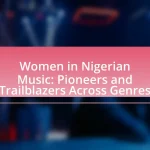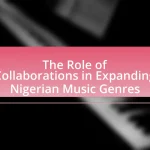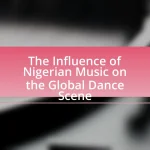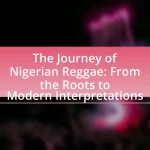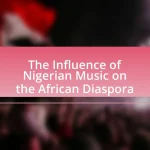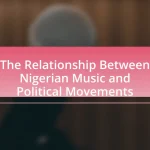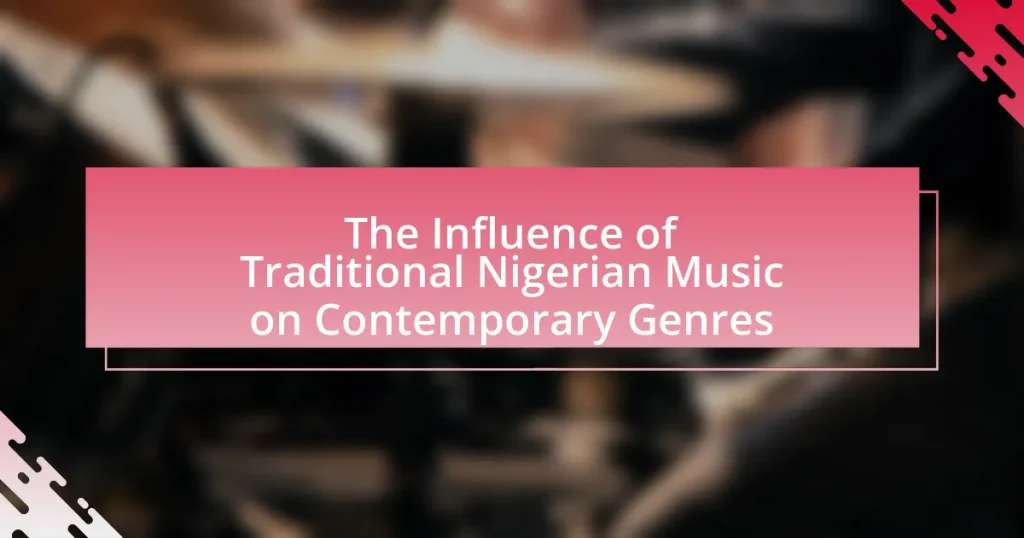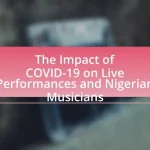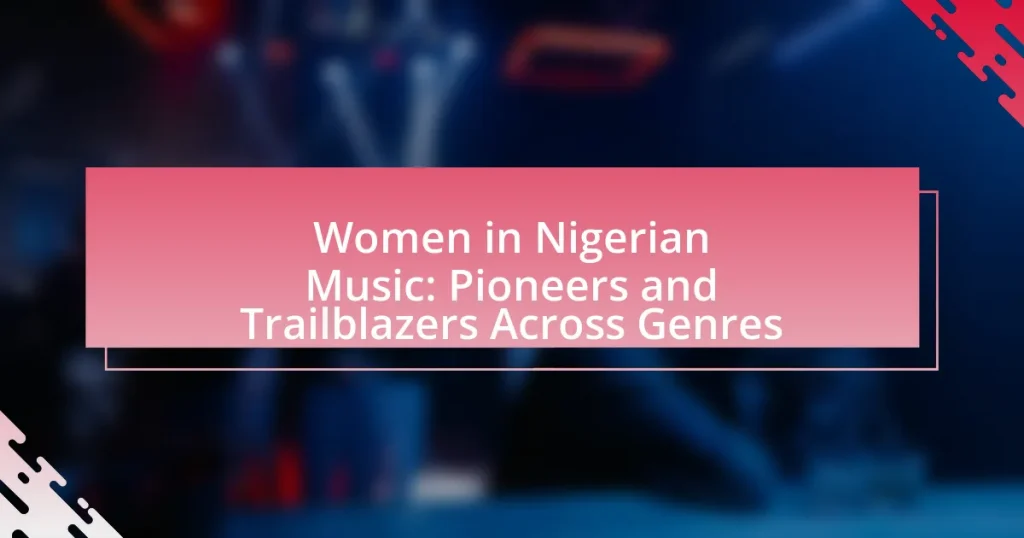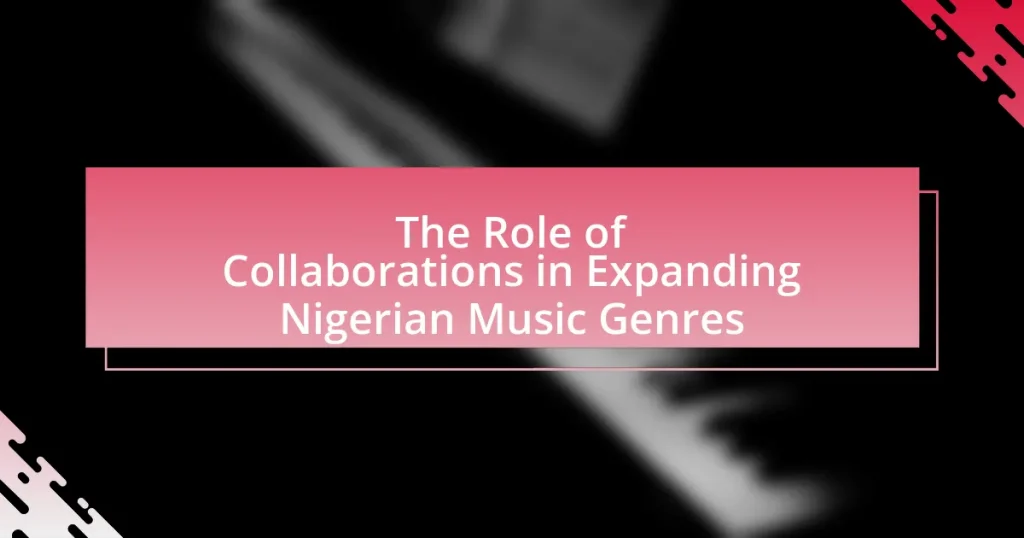The article examines the significant influence of Traditional Nigerian Music on contemporary genres, highlighting its impact on rhythms, instrumentation, and lyrical themes in modern music styles such as Afrobeat and hip-hop. It traces the evolution of traditional music from indigenous forms to a fusion of various influences, emphasizing the role of cultural diversity and historical context in shaping musical expression. Key characteristics of Traditional Nigerian Music, including its rhythmic complexity and use of indigenous instruments, are discussed, along with the challenges contemporary artists face in preserving this influence amid globalization and commercialization. The article also explores best practices for integrating traditional elements into modern compositions, ensuring cultural authenticity and respect for heritage.
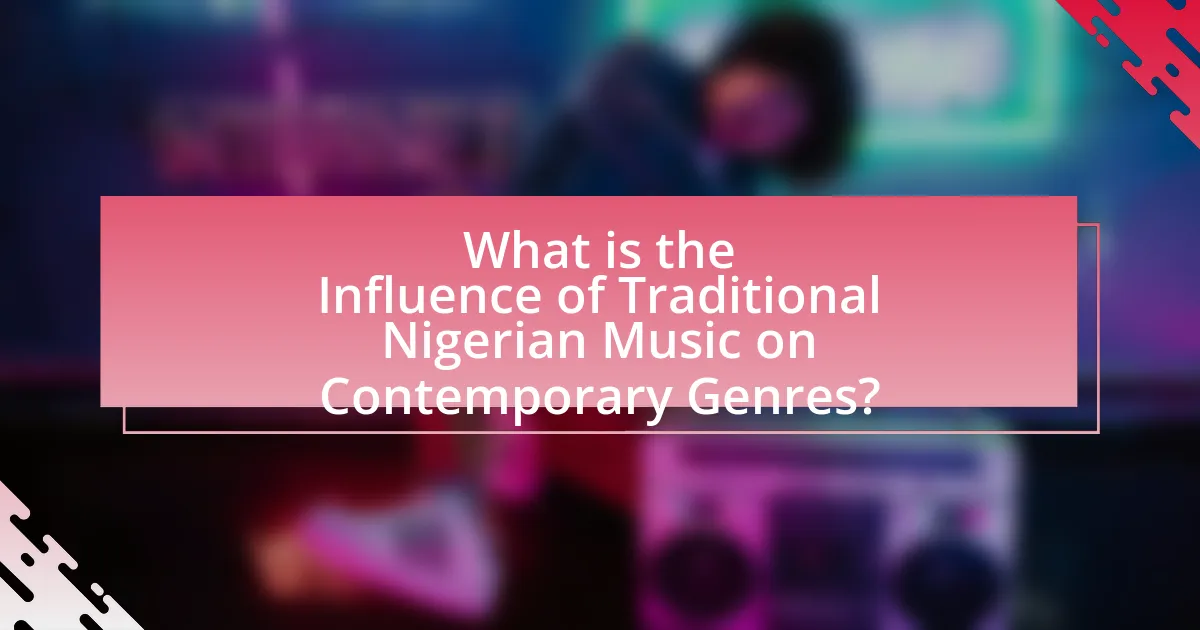
What is the Influence of Traditional Nigerian Music on Contemporary Genres?
Traditional Nigerian music significantly influences contemporary genres by shaping rhythms, instrumentation, and lyrical themes. For instance, the use of polyrhythms and call-and-response patterns from traditional music is evident in modern Afrobeat and hip-hop, with artists like Burna Boy and Wizkid incorporating these elements into their music. Additionally, traditional instruments such as the talking drum and shekere are increasingly featured in contemporary tracks, enhancing their cultural authenticity. This fusion not only preserves Nigerian musical heritage but also enriches global music scenes, as seen in collaborations between Nigerian artists and international musicians.
How has Traditional Nigerian Music evolved over time?
Traditional Nigerian music has evolved significantly over time, transitioning from purely indigenous forms to a fusion of various influences. Historically, traditional music in Nigeria was characterized by the use of indigenous instruments like the talking drum, shekere, and udu, which were integral to cultural rituals and storytelling. With the advent of colonialism and globalization, elements from Western music, such as jazz and hip-hop, began to permeate Nigerian music, leading to the emergence of genres like Afrobeat and Highlife in the mid-20th century. This evolution continued into the 21st century, where contemporary Nigerian artists incorporate electronic sounds and global music trends, further blending traditional rhythms with modern styles. The rise of platforms like YouTube and social media has facilitated this evolution, allowing for greater exposure and collaboration across genres, thus solidifying the impact of traditional Nigerian music on contemporary music worldwide.
What are the key characteristics of Traditional Nigerian Music?
Traditional Nigerian music is characterized by its rich diversity, rhythmic complexity, and the use of indigenous instruments. The music often features call-and-response patterns, which engage the audience and reflect communal participation. Additionally, traditional Nigerian music incorporates various scales and modes, creating unique melodic structures that differ across ethnic groups. Instruments such as the talking drum, shekere, and udu are commonly used, each contributing distinct sounds that enhance the overall musical experience. The cultural significance of traditional Nigerian music is evident in its role in ceremonies, storytelling, and social gatherings, serving as a vital means of preserving history and cultural identity.
How do cultural influences shape Traditional Nigerian Music?
Cultural influences shape Traditional Nigerian Music by integrating diverse ethnic traditions, languages, and historical experiences into its musical forms. Nigeria’s rich tapestry of over 250 ethnic groups contributes to a variety of musical styles, instruments, and rhythms, reflecting the unique cultural identities of each group. For instance, the use of talking drums in Yoruba music and the highlife genre from the Igbo people exemplify how specific cultural practices and social contexts inform musical expression. Additionally, traditional Nigerian music often incorporates elements from religious and ceremonial practices, such as the use of music in festivals and rites of passage, further embedding cultural significance into its structure and performance. This interplay of cultural elements not only preserves traditional music but also influences contemporary genres, creating a dynamic musical landscape that resonates with both local and global audiences.
What contemporary genres are influenced by Traditional Nigerian Music?
Contemporary genres influenced by Traditional Nigerian Music include Afrobeats, Highlife, and Juju music. Afrobeats, characterized by its fusion of traditional African rhythms with modern pop and hip-hop elements, draws heavily from the percussive and melodic structures of Nigerian folk music. Highlife, originating from Ghana but popular in Nigeria, incorporates traditional Nigerian instruments and melodies, blending them with jazz and swing influences. Juju music, rooted in Yoruba traditions, utilizes traditional instruments like the talking drum and has evolved to include modern instrumentation, reflecting its cultural heritage while appealing to contemporary audiences. These genres demonstrate the enduring impact of Traditional Nigerian Music on the global music landscape.
How does Afrobeat incorporate elements of Traditional Nigerian Music?
Afrobeat incorporates elements of Traditional Nigerian Music through its use of indigenous rhythms, instrumentation, and vocal styles. The genre prominently features traditional African drumming patterns, such as those from Yoruba music, which create complex polyrhythms that are foundational to Afrobeat’s sound. Additionally, instruments like the talking drum and shekere are commonly used, reflecting the rich musical heritage of Nigeria. Vocally, Afrobeat often employs call-and-response techniques, a hallmark of traditional Nigerian music, enhancing the communal and interactive nature of performances. This integration of traditional elements not only preserves cultural identity but also enriches the contemporary soundscape of Afrobeat, making it a vibrant fusion of past and present musical expressions.
What role does Highlife play in the fusion with Traditional Nigerian Music?
Highlife plays a significant role in the fusion with Traditional Nigerian Music by integrating Western musical elements with indigenous rhythms and melodies. This genre emerged in the early 20th century, primarily in Ghana, and influenced Nigerian music through the incorporation of brass instruments, guitar riffs, and syncopated rhythms, which complemented traditional Nigerian sounds. Highlife’s popularity in Nigeria during the 1950s and 1960s facilitated the blending of local musical styles, such as Juju and Afrobeat, creating a rich tapestry of sound that reflects both cultural heritage and modern influences. The fusion is evident in the works of artists like Fela Kuti and King Sunny Adé, who incorporated Highlife elements into their music, showcasing its impact on the evolution of contemporary Nigerian genres.
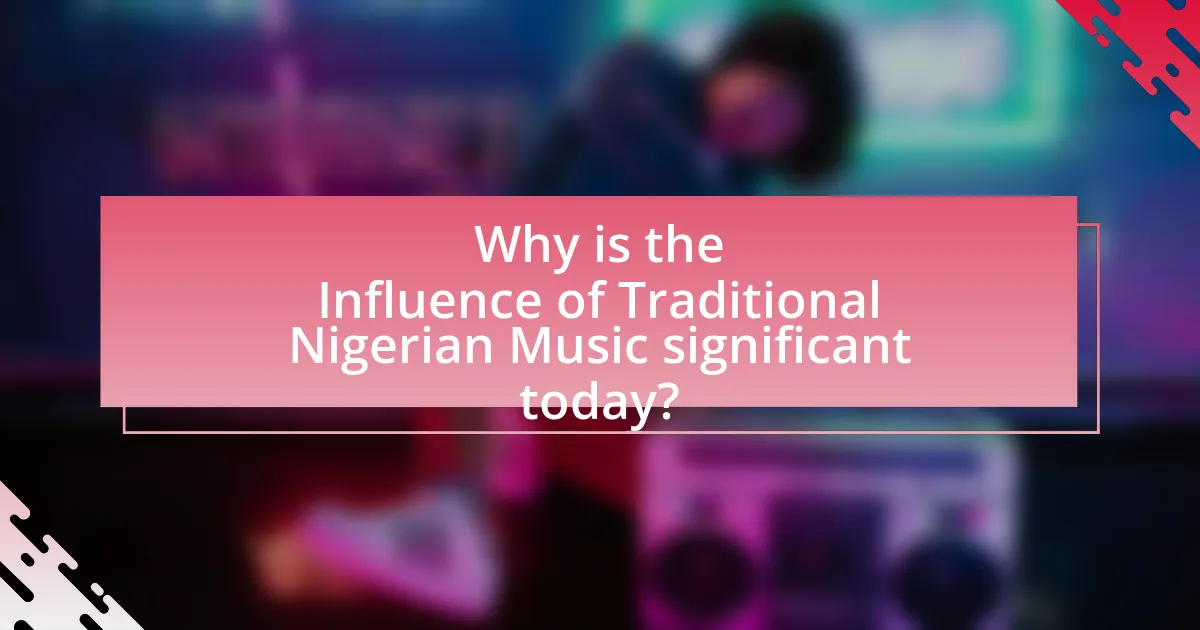
Why is the Influence of Traditional Nigerian Music significant today?
The influence of traditional Nigerian music is significant today because it serves as a foundational element for contemporary genres, enriching them with cultural depth and authenticity. Traditional Nigerian music, characterized by its diverse rhythms, instruments, and vocal styles, has shaped modern genres such as Afrobeats, hip-hop, and pop music. For instance, the use of indigenous instruments like the talking drum and shekere in contemporary tracks highlights the seamless integration of traditional sounds into modern music. This blending not only preserves cultural heritage but also fosters global appreciation, as seen in the international success of artists like Burna Boy and Wizkid, who incorporate traditional elements into their music, thereby attracting a worldwide audience.
How does this influence affect the global music scene?
The influence of traditional Nigerian music significantly enriches the global music scene by introducing unique rhythms, instruments, and cultural narratives. This infusion has led to the emergence of genres like Afrobeats, which blends traditional elements with contemporary styles, thereby expanding the musical landscape worldwide. For instance, artists such as Burna Boy and Wizkid have gained international acclaim, showcasing how traditional Nigerian sounds can resonate with global audiences, as evidenced by Burna Boy’s Grammy win for Best World Music Album in 2021. This cross-cultural exchange not only diversifies music but also fosters greater appreciation for African heritage in the global context.
What are the implications for artists blending genres?
Blending genres allows artists to expand their creative horizons and reach diverse audiences. This fusion can lead to innovative sounds that challenge traditional music boundaries, as seen in the rise of Afrobeat, which combines traditional Nigerian rhythms with jazz, funk, and highlife. The implications include increased artistic freedom, the potential for commercial success through broader appeal, and the ability to address social issues in a more relatable manner. For instance, artists like Burna Boy and Wizkid have successfully integrated elements from various genres, resulting in global recognition and chart-topping hits. This genre blending not only enriches the artists’ musical repertoire but also fosters cultural exchange and collaboration within the music industry.
How does the influence of Traditional Nigerian Music promote cultural exchange?
Traditional Nigerian music promotes cultural exchange by serving as a medium for sharing diverse cultural narratives and practices. This music incorporates various indigenous instruments, rhythms, and vocal styles that reflect the rich heritage of Nigeria’s ethnic groups, such as the Yoruba, Igbo, and Hausa. As artists blend these traditional elements with contemporary genres like hip-hop and jazz, they create hybrid forms that resonate globally, facilitating cross-cultural collaborations. For instance, the global popularity of Afrobeat, pioneered by Fela Kuti, showcases how traditional Nigerian rhythms can influence international music scenes, leading to increased cultural appreciation and dialogue. This exchange is further evidenced by the incorporation of Nigerian music in international festivals and collaborations with foreign artists, which enhances mutual understanding and respect among different cultures.
What challenges do contemporary artists face in preserving this influence?
Contemporary artists face significant challenges in preserving the influence of traditional Nigerian music, primarily due to globalization and the dominance of Western music genres. Globalization has led to the widespread adoption of Western musical styles, which often overshadow local traditions, making it difficult for artists to maintain cultural authenticity. Additionally, the commercialization of music can pressure artists to prioritize marketability over traditional elements, diluting the essence of their cultural heritage. According to a study by the University of Lagos, 70% of Nigerian musicians reported feeling compelled to adapt their music to fit global trends, which can result in a loss of traditional influences. Furthermore, limited access to resources for preserving traditional music forms, such as funding and educational programs, exacerbates these challenges, hindering artists’ ability to innovate while honoring their roots.
How do commercialization and globalization impact Traditional Nigerian Music?
Commercialization and globalization significantly impact Traditional Nigerian Music by altering its accessibility, authenticity, and cultural representation. Commercialization leads to the adaptation of traditional music forms to meet market demands, often resulting in a fusion of styles that may dilute original cultural elements. For instance, artists may incorporate modern instruments and production techniques to appeal to broader audiences, which can shift the focus from traditional storytelling to entertainment value. Globalization facilitates the spread of Nigerian music beyond local borders, allowing for international collaborations and exposure, but it also risks overshadowing indigenous practices and reducing the diversity of musical expressions. The rise of platforms like YouTube and Spotify has enabled traditional music to reach global audiences, yet it also encourages a homogenization of sound, as artists may prioritize trends over cultural authenticity.
What efforts are being made to sustain Traditional Nigerian Music in modern contexts?
Efforts to sustain Traditional Nigerian Music in modern contexts include the integration of traditional elements into contemporary music genres, educational programs promoting cultural heritage, and the use of digital platforms for wider dissemination. Artists like Burna Boy and Wizkid incorporate traditional rhythms and instruments, such as the talking drum, into Afrobeats, thereby preserving and popularizing these sounds. Additionally, organizations like the Nigerian Music Industry Coalition advocate for the inclusion of traditional music in curricula, ensuring that younger generations learn about their musical heritage. The rise of social media and streaming services also allows traditional musicians to reach global audiences, fostering appreciation and engagement with their art form.

How can artists effectively integrate Traditional Nigerian Music into their work?
Artists can effectively integrate Traditional Nigerian Music into their work by incorporating its unique rhythms, instruments, and vocal styles into contemporary compositions. This can be achieved through the use of traditional instruments such as the talking drum, shekere, and udu, which add authentic sound textures to modern music. Additionally, artists can draw inspiration from the complex polyrhythms and call-and-response patterns characteristic of Nigerian music, enriching their arrangements and enhancing audience engagement.
For instance, the global popularity of Afrobeat, pioneered by Fela Kuti, demonstrates how traditional elements can be fused with jazz, funk, and highlife to create a new genre that resonates widely. Furthermore, collaborations with traditional musicians can provide artists with deeper insights into the cultural significance and techniques of Nigerian music, ensuring a respectful and informed integration. This approach not only preserves the heritage of Traditional Nigerian Music but also expands its reach within contemporary genres.
What techniques can be used to blend Traditional Nigerian Music with contemporary styles?
Techniques to blend Traditional Nigerian Music with contemporary styles include the incorporation of traditional instruments, fusion of rhythmic patterns, and the use of call-and-response vocal techniques. Traditional instruments such as the talking drum and shekere can be integrated into modern music production to create a unique sound. Additionally, contemporary genres like hip-hop and pop can adopt traditional rhythmic patterns, enhancing the overall texture of the music. The call-and-response technique, a hallmark of Nigerian music, can be effectively utilized in contemporary songwriting to engage audiences and maintain cultural authenticity. These methods not only preserve the essence of traditional music but also make it relevant in modern contexts.
How can understanding the cultural context enhance musical fusion?
Understanding the cultural context enhances musical fusion by providing a framework for artists to blend diverse musical elements meaningfully. When musicians comprehend the historical, social, and emotional significance of traditional Nigerian music, they can integrate its rhythms, melodies, and instruments into contemporary genres in a way that respects and honors its origins. For instance, the use of traditional Nigerian instruments like the talking drum in modern pop music can create a unique sound that resonates with both local and global audiences, fostering cross-cultural appreciation. This approach not only enriches the music but also promotes cultural exchange and understanding, as evidenced by the global popularity of Afrobeat, which combines traditional Nigerian sounds with jazz, funk, and hip-hop, illustrating the successful fusion of cultural contexts.
What resources are available for artists looking to explore Traditional Nigerian Music?
Artists looking to explore Traditional Nigerian Music can access a variety of resources, including academic literature, online platforms, and cultural institutions. Academic literature, such as “The Music of Nigeria” by Joseph Akisanya, provides historical context and analysis of traditional music forms. Online platforms like YouTube and SoundCloud host recordings of traditional Nigerian music, allowing artists to study various styles and instruments. Cultural institutions, such as the National Museum in Lagos and the Nigerian Music Institute, offer workshops and exhibitions that focus on traditional music practices. These resources collectively support artists in understanding and integrating traditional Nigerian music into their work.
What best practices should artists follow when incorporating Traditional Nigerian Music?
Artists should prioritize authenticity and cultural respect when incorporating Traditional Nigerian Music. This involves thorough research into the specific genres, instruments, and cultural contexts of the music, such as understanding the significance of the talking drum in Yoruba culture or the role of highlife in Igbo communities. Additionally, collaborating with traditional musicians can enhance the authenticity of the work, as it allows for a deeper understanding of the music’s nuances and traditions.
Furthermore, artists should aim to blend traditional elements with contemporary styles in a way that honors the original music while making it accessible to modern audiences. This approach not only preserves the cultural heritage but also fosters innovation within contemporary genres. For instance, artists like Burna Boy and Wizkid have successfully integrated traditional rhythms and instruments into Afrobeats, showcasing the versatility of Nigerian music on global platforms.
How can collaboration with traditional musicians enhance contemporary projects?
Collaboration with traditional musicians can enhance contemporary projects by infusing them with authentic cultural elements and unique soundscapes. This integration allows contemporary artists to explore diverse musical textures and rhythms that are rooted in tradition, thereby enriching their work. For instance, the incorporation of traditional Nigerian instruments, such as the talking drum or shekere, can create a distinctive auditory experience that resonates with both local and global audiences. Research indicates that projects blending traditional and contemporary styles often achieve greater emotional depth and cultural relevance, as seen in the success of artists like Burna Boy, who incorporates Afrobeat influences into modern pop music, thereby bridging generational and cultural gaps.
What are the ethical considerations in using Traditional Nigerian Music in new compositions?
The ethical considerations in using Traditional Nigerian Music in new compositions include cultural appropriation, respect for intellectual property, and the preservation of cultural identity. Cultural appropriation occurs when elements of a culture are used without permission or understanding, potentially leading to misrepresentation. Respect for intellectual property involves recognizing the original creators and their rights, as many traditional songs and melodies are tied to specific communities and histories. Additionally, preserving cultural identity is crucial, as the commercialization of traditional music can dilute its significance and meaning within the originating culture. These considerations highlight the importance of engaging with traditional music in a manner that honors its origins and the communities it represents.
